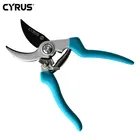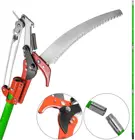Pruners, also called garden pruning shears or secateurs or hand pruners, and even garden scissors, are cutting tools to treat plants, viticulture, and gardening. Pruning is one of the most significant and beneficial practices in viticulture and horticulture that must be performed irrespective of the type of vine or the plant type you are growing in your vineyard or garden.
Whether vine or ornamental plants or flowering or fruiting plants, these pruning or cutting methods are vital for your plant health, and you should never avoid cutting because of any reason. You all have to be conscious of pruning advantages – whether to promote branching and plant growth or eliminate diseased branches or even improve fruiting and flowering. But O.K., for now, we will not go into particulars of pruning advantages.
This study will discover the different types of garden pruning shears or cutting tools we use in viticulture and home gardening. Many beginners, gardeners, and winegrowers are not conscious of the right type of pruners they need. But it is essential to note that using the incorrect pruners might negatively harm your plants or vines instead of fixing them.
So, now let’s look at the different types of Pruners:
1. Hand Garden Pruning Shears or Hand Pruners:
These are the most usually used cutters in home gardening and viticulture. These are of two sorts:
a. Bypass Garden Pruning Shears
b. Anvil Garden Pruning Shears
Bypass garden pruning shears have curved scissor-like knives that overlay. These are perfect for cutting soft and younger branches. These are the regularly used pruners in viticulture and home gardening. They are also useful for obtaining stem cuttings at a 45-degree cutting angle to reproduce plants from the stem cuttings. But don’t buy the cheapest or the most complicated ones. Simplicity is an advantage even here. I recommend the ones you see here in the picture. Click on them to purchase.

Anvil garden pruning shears are made with a flat lower plate and a straight upper blade. The straight upper blade cuts against a flat lower plate, which seems like an anvil. ANVIL means a large iron slab on which heated metals are hammered into form. Well, These Anvil pruners could crush the stem while they cut and are suitable for woody branches that won’t be wrecked by crushing. So remember not to use them on soft branches that can be crushed. You can use them only on woody or semi-woody branches.
2. Loppers Shears or Loppers Pruners:

These are comparable to the hand garden pruning shears but have extended handles that give a little more range than hand shears. They are proper for heavy-duty pruning for up to three-fourths to 1-inch diameter cuttings. And I’ll repeat. Likewise, these are of two sorts—bypass and Anvil type.
3. Pole Pruners:

Pole pruners are formed of blades connected to hooks. These hooks are positioned on large poles, and a cord or chain manages the blade, which usually is spring-loaded. Pole pruners can normally touch branches 12 feet above the terrain. When using a ladder is not reasonable, we typically use this pruner.
4. Hedge Shears or Hedge Pruners:
These are intended for the fast trimming of hedges. A hedge indicates a barrier or fence fixed by tight-growing bushes or shrubs or maybe grass.
This type of hedge shear occurs in a variety of designs and sizes. They have large, angled, or straight blades that are sharp and appropriate to cut many branches at once. The larger blades of hedge shears ensure an even cut across the plant branches to maintain a balanced and neat design. You can apply them to make an elegant border of various plants.
5. Pruning Saw:

These types appear in a variety of blades and sizes with teeth that are fine or not so fine, and also, a folding model is possible. This pruning saw should be pretty well-built and handy for home gardening goals. These saws are usually applied for stems that are more than 1-1/2 inches in diameter, which are typically too big for lopping with shears or hand pruners.
6. Garden Pruning Shears-Flower Cutter (Floral Snips).

This is a simplistic bypass pruner to prune tiny flowers or branches. These have a spring system and are lightweight. And they are best for performing deadheading and the “pinching” method for making your plant bushy and more branching. I’m sure you all are aware of its benefits.
7. Garden Pruning Shears-Ratchet Pruners

These types of garden pruning shears significantly diminish the stress of pruning. The ratchet drive enables you to cut thicker stems easily and decreases hand exhaustion. These pruning shears are excellent for anyone with hand injuries or difficulties. But in fact, these pruning shears are good for all those who require additional pressure while cutting.
Remember that it’s always good for all hand-held mechanisms if you lubricate them well.
8. Last but Not Least. a Plain Scissor Can Do a Bunch of Good Works.

I’m convinced all of you agree with this. This tool is a convenient and beneficial weapon in gardening.
Happy Viticulture and Gardening!
